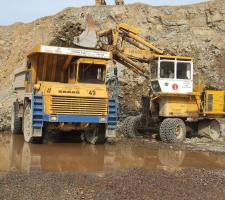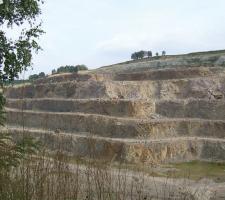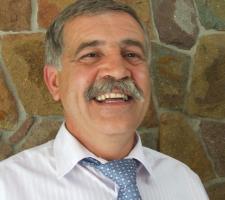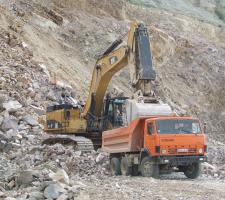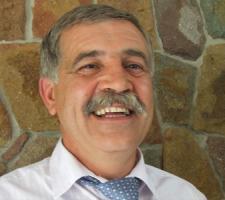
Nine years on from privatisation Poland's Kopalnie Porfiru i Diabazu attributes it success to continual investment. Claire Symes visited the site to find out more
Quarry companies with shareholders numbering in the hundreds are not unusual in Europe, but ones where the majority of the shareholders are also employees are less common. But in Poland many previously state-owned operations have been privatised in this way and have been turned from non-profit making organisations into lucrative and investment-led operations.
Krzesowice-based Kopalnie Porfiru I Diabazu is a prime example of the success of this Polish business model with a high proportion of the 200 shareholders forming part of the 230-strong workforce. The business, which was privatised in 2000, has two quarries producing high quality aggregates from porphyry and diabase deposits and investment in a third gravel quarry in the planning stages.
Since privatisation, leadership of the business has been the responsibility of chairman Jan Zaluski but he has worked at the quarries for 20 years, so knows the challenges of the business well.
"When the company was privatised the production from both quarries was 600,000 to 700,000tonnes per year with a maximum capacity of 800,000tonnes," said Zaluski. "When it was state-owned nearly all the material was used for railway construction work, rather than the high-end applications which deposits of this quality are more suited to.
"Since then we have worked to develop the road and construction markets for our aggregates. Now around 70% of our 1.5million tonne per year production goes into roads and general construction, with the remainder still used by the rail sector. This restructuring has helped the business to become profitable but we have also invested money in new technology to meet the demands of this new market's requirements." The company's headquarters are still in the modest buildings it owned during its state run days - the only real change is that the far wall of the board room is now decorated with stone from the porphyry quarry. "Decorative stone has been a surprising growth market for us in the last years," explained Zaluski. "I'd estimate that around 20% of our production goes into this market now."
Geological opportunities
The company's oldest quarry is the diabase one, which dates back over 100 years, but now has just 10 years of reserves left. The company produces around 200,000tonnes from this site each year and the aggregates are mainly used for high specification asphalt or B50 cement.
The porphyry quarry is just 2km from the diabase extraction area and has a much longer future. The quarry was opened 35 years ago and, when asked how many years of reserves there are at the site, Zaluski said that the site would outlast his grandchildren.
Overburden at the porphryr quarry is up to 30m thick and removal of this has been the subject of Kopalnie Porfiru i Diabazu's latest investment as well as being the key to restoring the diabase site.
"Until two years ago we had tried to drill and blast the partially cement overburden but it was not a good approach as the material was so variable," explained Zaluski. "Our local
At the moment, the overburden from the porphyry quarry is being stockpiled on site but eventually it will be used to backfill the exhausted areas of the diabase quarry. The final restoration plan is to return the diabase site back to forestry use.
Workforce
The quarries operate two shifts per day - 6am to 2pm and 2pm to 10pm - to keep pace with demand. The company's 230-strong workforce are not fixed at one site but are drafted between the two depending on demand. "This number of employees may sound high compared to Western European operations but we don't outsource any part of the production," said Zaluski.
This makes Kopalnie Porfiru i Diabazu the second largest employer in the area, which has helped to keep relations with the local communities good - particularly at the porphyry which is very close to residential properties. But even when the operatives become too old to work within the production side of the quarry Kopalnie Porfiru i Diabazu employs them as security guards. "Our retired workforce know the quarry and are also loyal to the company, so having them providing security is an ideal solution for everyone," said Zaluski.
Many of the 230-strong workforce and retirees are shareholders in the business. Zaluski explained that their shareholders' rights only apply during the annual general meeting and the rest of the year they operate as conventional employees. Nonetheless, Zaluski said the company owes its stability and investment-rich approach to the support of its shareholders. "Voting at the AGM is secret but everyone has always fully supported the proposals of the board as they understand that we are working to make the company profitable both now and in the future," he said. "Having their full support makes for a good working environment here." Although Zaluski is now chairman of the company, he became manager when he was 31 and helped to drive the privatisation. He joined the state-owned holding company in 1989 after five years working in another quarry, where he worked as the chief electrical engineer. Zaluski graduated from the electrical department of the technical university in Krakow and jokes that the only person on site who is afraid of him is the company's electrical engineer.
"We try to create a working environment where people take responsibility for their actions and have the chance to resolve problems themselves," he said. "In my experience, it helps to keep people satisfied in their work and this is what separates us from some of the large multinational quarrying companies. Privatisation has been a key part of that - it brought the opportunity for employees to profit from their work through more than just a salary."
Blasting
The porphyry quarry operates with 22m high benches and uses drill and blast to extract the rock. "We use 100mm diameter blast holes but the drill pattern and spacing depends on where the blast is located in the quarry as well as how clean the face is. We are close to the village here so we generally use smaller charges than we would at the diabase quarry and we also have to close the local roads during blasting," said Zaluski. "The geology is fairly homogeneous which does help.
"There is a limit imposed on us by the mining authorities on the amount of explosives we can use per blast.
On average we use about 1tonne per day and blast a few thousand tonnes of rock each time but it varies." The company has a fleet of four Hausherr drill rigs that it moves between the quarries as they are needed.
Despite careful design, each blast at the porphyry quarry results in about 15% of oversize material - anything over 1.2m. One of the quarry's two Böla excavators is fitted with a grapple to allow it to use a 7tonne drop ball to break the oversized material at the face and avoid blocking the crusher.
In addition to the two Böla front shovel excavators and the Cat 365 used for ripping, the quarry's prime mover is a Cat 385 front shovel and the site also has three electric drive Škoda front shovels.
"Neither the Cat or Böla excavators are big enough to pick off any lose rocks from the crest of the bench if the blast leaves an overhang, so we keep the Škoda machines for that purpose," said Zaluski. "They are costly to operate but safety is important. The youngest of the three we have is about 25 years old - I wouldn't buy that kind of machine now but we use them because they are available." The blasted rock is hauled from the face to the static crushing plant using a fleet of
Drill rig
4x Hausherr Bohrtechnik rigs
wheeled loaders
3x Cat 972H
1x Cat 966GII
3x Huta Stalowa Wola
excavators
1x Cat 365CME with a quick coupler and TR70 ripper
1x Cat 385C FS
2x Böla 5m3 front shovels 3x Škoda 120tonne electric drive
rigid dump trucks
13x Belaz 45tonne
breakers
1x 7tonne drop ball
2x 1.2tonne Krupp
PRIMARY CRUSHER
2x DCJ
Secondary crusher
2x Metso Minerals jaw crushers
Tertiary crushing
2x Metso Minerals HP300 cone crushers
1x Makrum cone crusher
mobile crusher
1x Terex Pegson impact crusher
Additional crushing capacity is provided by a
"My role is to marry output at the face with the capacity of the crushing and screening unit and the loading operations," said Zaluski. "The aim is to produce 2700tonnes of aggregates per shift and to eliminate any waiting time for customers collecting material." The quarry has its own 7km long rail siding that connects into the national Polish rail network and around 40% of deliveries are made this way. "The customers' or logistics companies' trains are loaded by a gravity-fed silo," said Zaluski. "The rest of the production is transported by road." Kopalnie Porfiru i Diabazu has a policy to only use wheeled loaders in the load out area and not at the face as it believes that front shovel excavators are more productive. "The tracked design of the shovels means that they are more productive in a hard rock environment that exists in both of our quarries," said Zaluski.
In the loading area, at the porphyry quarry there are seven wheeled loaders - four Cat units and three from Poland-based manufacturer
Markets
Although Kopalnie Porfiru I Diabazu is located in the south of Poland, its materials are delivered over a wide area that is not only influenced by transport but also the surrounding geology. "Most of the aggregates extracted here are used in the construction and roads markets to the east of here," explained Zaluski. "To the west, the markets are well served by other hard rock quarries but to the east the extraction is mainly limestone and dolomite. The rail links at the porphyry quarry mean that our aggregates are transported over a much wider area than might normally be expected and we often supply customers to the north in Gdansk and Warsaw.
"Under the old state owned regime, material was transported all over the country and this was just not sustainable or profitable.
"We do sometimes export material southwards into Slovakia if there is a big project underway there but sales like that are rare." Nonetheless, the quarry does attract national interest of another kind - that as a working laboratory for geology students. "A lot of the technical universities in Poland send students to visit our quarries as we have very good cross sections of geological time periods here," said Zaluski. To illustrate the richness of the history, the company has produced a booklet to show the geological history and the fossils that have been uncovered at the site. "Organising the visits is difficult with the blasting operations," he said. "But it is a worthwhile investment in the future - it is good for the quarry to be well known with the next generation of construction professionals as they may be our future customers."
Investment
Kopalnie Porfiru I Diabazu takes investment in new technology very seriously. "There was a real need to invest after privatisation to improve the cost efficiency and add new technology," said Zaluski. "But continuous investment is also important to keep moving the operation forward." In the porphyry quarry the most recent acquisition is the Cat 365 and ripper but other investments have included the Metso Minerals crushing and screening plant in 2003. In addition, the shareholders set up a separate company to add asphalt production to the company's portfolio and the plant is located at the diabase quarry. The 240tonnes per hour asphalt plant was the most modern of its kind in Poland when it was commissioned in 2004.
But with reserves at the diabase quarry only predicted to last another 10 years, the company has started to look at increasing its reserves elsewhere. "We are looking at buying a new gravel quarry about 100km from here and we hope to have the site operational by April 2010," said Zaluski.
However, Zaluski said that the exact start date could not be predicted as the approval of the licence depends on the authorities. "Starting a new company in Poland is always a challenge but it is one we have successfully managed with both the privatisation and the establishing of our asphalt business," he said. "It could take a month or a year to get the final approval and there is nothing that can be done to speed the process." Zaluski said that he wished the legislation and regulation was similar to that in Western Europe as the Polish system is too administrative and bureaucratic. "Each government promises to limit the administration but the clerks always seem to win in the end," he said. "However, the arrival of international quarrying companies into the Polish aggregates market is paving the way for change."
Economic opportunity
Zaluski believes that now is a good time to invest in the aggregates market in Poland. "The global economic crisis has not really impacted on our business here in Poland," he said. "This year will be down on last year but not significantly so. We had planned our operation to cope with a bigger hit from the crisis than we have actually seen and this puts us in a good position to move forward with developing the business."


